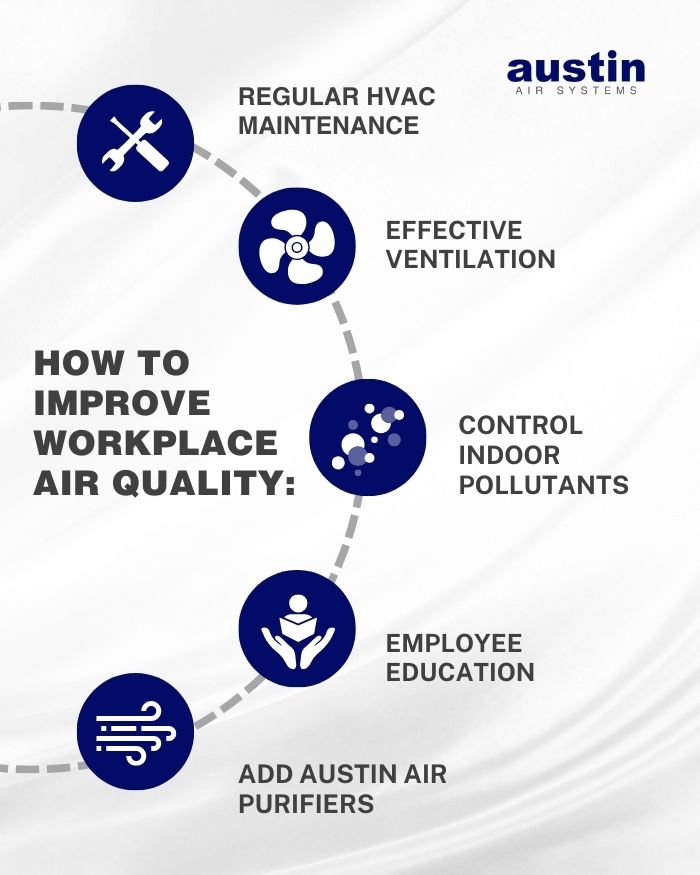In today’s fast-paced corporate landscape, every decision has a potential impact on profitability. The data has shown – it’s essential to recognize the correlation between employee health, productivity, and the quality of the air they breathe.
The concept of air quality might conjure images of distant industrial smokestacks or polluted cityscapes, but it’s crucial to give thought to the air circulating within our offices, factories, and commercial spaces that can significantly impact the bottom line.
Consider this: employees spend a substantial portion of their day within the confines of their workplace. When that indoor air quality (IAQ) is low due to pollutants or insufficient ventilation, it can impair health, cognitive function, and focus. From subtle sniffles to more pronounced respiratory ailments, the health issues stemming from poor indoor air quality not only affect individual employees but also impact the financial health of businesses in terms of productivity, absenteeism, and employee errors.
Understanding the Impact of Indoor Air Quality on Employee Health
Poor IAQ in the workplace stems from various sources, including inadequate ventilation, indoor pollutants such as volatile organic compounds (VOCs) that off-gas from plastic appliances or harsh cleaners, plus allergens and irritants like mold, dust, and pollen.
Prolonged exposure to these contaminants can lead to a myriad of health problems, ranging from minor irritations of the nose and throat to more severe respiratory conditions. Employees working in environments with poor air quality are more prone to respiratory infections, allergies, asthma exacerbations, and other respiratory ailments.1
These health issues not only compromise individual well-being but also contribute to increased absenteeism and decreased productivity. Moreover, poor indoor air quality can worsen existing health conditions, leading to higher healthcare costs for both employees and employers.
Sick Building Syndrome (SBS) is a term used to describe a range of symptoms experienced by occupants of a building, that are linked to time spent within that building – typically office buildings and schools. These symptoms may include headaches, fatigue, eye and throat irritation, and respiratory issues, among others. SBS is often attributed to poor indoor air quality from inadequate ventilation and high levels of indoor pollutants from building materials and items such as printers. It can negatively impact employee health, comfort, and productivity, leading to increased absenteeism and reduced overall well-being.2 A key indicator of SBS is that symptoms subside once a person has left the building and all too often, these are places of employment.
The Link Between Indoor Air Quality and Productivity
Beyond its direct impact on employee health, IAQ also has a significant influence on cognitive function and productivity levels in the workplace.
A study conducted by Harvard T.H. Chan School of Public Health found that employees working in well-ventilated offices with lower levels of indoor pollutants had significantly higher cognitive function scores “in crucial areas such as responding to a crisis or developing strategy,” compared to those in poorly ventilated spaces. This means that air quality can be a game changer when it’s time to think fast, a regular requirement in most business operations.3
Another study, also led by Harvard, followed workers in six different countries and the quality of air in the office setting. They found that IAQ can profoundly influence employees’ cognitive abilities, impacting factors such as response times and concentration for. Additionally, this study suggests that it has implications for their overall productivity levels.4
Scientists are only just beginning to understand the impact of air quality on brain function but this cutting edge research makes it clear – if you want your employees to be at their best, they need clean air in the workplace.
The Hidden Costs of Neglecting Workplace Air Quality
While the consequences of poor indoor air quality on employee health and productivity are well-documented, the true cost to businesses often remains hidden beneath the surface. Beyond the immediate impacts on absenteeism and decreased productivity, there are additional financial implications that can significantly affect the bottom line – healthcare expenses.
Employees suffering from respiratory ailments or other health issues related to poor indoor air quality require more frequent medical attention, prescription medications, and are also more likely to require hospitalization for conditions like asthma. These healthcare expenses not only burden the affected employees but also contribute to rising healthcare costs for employers, especially those providing health insurance coverage to their workforce.
The American Lung Association reports that asthma costs employers $10 billion every year and 200 million days of productivity are lost each year due to the flu. Quartz, the online business magazine, reports that employers are losing $125 billion annually as a result of air pollution tied to wildfires. Using data from the environmental think tank First Street, Quartz is projecting that this trend will grow to $334.1 billion per year by 2054.6
The impact of poor indoor air quality extends beyond the affected individuals to the broader workforce. When coworkers are sick or experiencing discomfort due to poor air quality, it can negatively affect team dynamics, collaboration, and overall morale. Additionally, the reputation of a workplace can be harmed if it is known for its poor air quality, deterring potential hires and eroding employee loyalty over time.

Investing in a Healthy Future: Steps to Improve Workplace Air Quality
Given the compelling evidence linking indoor air quality to employee health, productivity, and financial performance, it’s clear that businesses have much to gain by prioritizing this often overlooked aspect of workplace well-being. Fortunately, there are several proactive steps that employers can take to improve indoor air quality and reap the benefits of a healthier, more productive workforce:
Regular HVAC Maintenance: Ensure that heating, ventilation, and air conditioning (HVAC) systems are properly maintained and regularly serviced to optimize air circulation and filtration.
Effective Ventilation: Increase ventilation rates and introduce outdoor air into the workplace to dilute indoor pollutants and maintain optimal air quality levels.
Control Indoor Pollutants: Implement measures to minimize indoor pollutants, such as banning smoking and vaping indoors, using low-VOC building materials, and reducing the use of chemical cleaning products.
Employee Education: Educate employees about the importance of indoor air quality and encourage them to report any issues or concerns promptly.
Add Filtration from Austin Air: Install portable Austin Air purifiers featuring a combination of HEPA and activated carbon that removes up to 99% of all airborne contaminants as small as 0.1 microns such as dust, pollen, mold spores, and VOCs.
By investing in these measures to improve indoor air quality, employers can create a healthier, more comfortable work environment that fosters employee well-being, satisfaction, and productivity. Moreover, by mitigating the hidden costs associated with poor air quality like decreased cognitive function, businesses can achieve long-term savings and sustainable growth.
Clearing the air in the workplace isn’t just a matter of compliance or corporate responsibility — it’s a strategic investment in the well-being and success of the workforce.
April 4 is World Corporate Health Day – an excellent time to give thought to the air quality in your workplace.

REFERENCES
1 Indoor Air Quality – Overview. (n.d.). Occupational Safety and Health Administration. https://www.osha.gov/indoor-air-quality.
2 Indoor Air Facts No. 4 Sick Building Syndrome. (n.d.) US EPA. https://www.epa.gov/sites/default/files/2014-08/documents/sick_building_factsheet.pdf.
3 Allen, JG, MacNaughton, P, Satish, U, et al. (2016, June 1). Associations of Cognitive Function Scores with Carbon Dioxide, Ventilation, and Volatile Organic Compound Exposures in Office Workers: A Controlled Exposure Study of Green and Conventional Office Environments. Envi H Pers.Vol 124,Issue 6,805 – 812. doi: 10.1289/ehp.1510037.
4 Cedeño Laurent, JG, MacNaughton, P, Jones, E, et al. (2021, Sept 9). Associations between acute exposures to PM2.5 and carbon dioxide indoors and cognitive function in office workers: a multicountry longitudinal prospective observational study. Environ. Res. Lett. 16 094047. doi: 10.1088/1748-9326/ac1bd8.
5 How Lung-Friendly is Your Workplace? (n.d.) American Lung Association. https://www.lung.org/getmedia/4d23cce7-3a37-446e-8180-248253f739dc/how-lungfriendly-workplace.pdf.pdf.
6 Bratton, L. (2024, February 20). Here’s how much bad air quality from wildfires will cost U.S. employees by the 2050s. Quartz. https://qz.com/air-quality-climate-change-cost-us-businesses-workers-1851252891.
